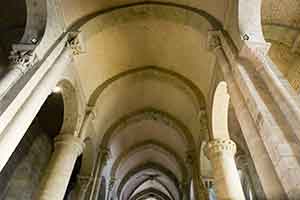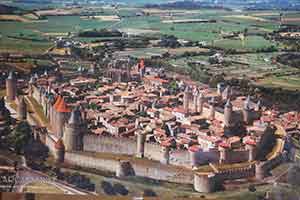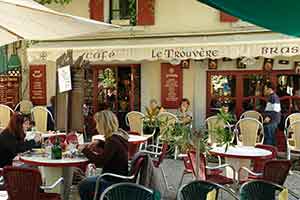Click button for detailed article about each place.
CARCASSONNE

Carcassonne is one of the world’s most magical places, a double-walled medieval city with a forest of towers rising tall and pointed. This largest medieval fortress in France consists of a concentric circle of two outer stone walls with 53 towers and barbicans to prevent attack, surrounding a well-preserved village. There's something about castles like this that appeals to the kid in all of us and really fires up the romance of the past.
One of the most rewarding activities is strolling about on the narrow cobblestone lanes within the walled village where no cars are allowed. It's not a large town by any means, just one-quarter mile long (500 meters), so it's easy to walk within the walled area and see nearly everything in a day. Two main lanes and several side lanes make up the entire plan, and yet there is enough to keep you amused, admiring the historic buildings, looking at the shops and going to the museum inside the castle.
Actually the whole village functions as a large castle, with the double layer of walls running all the way around it. The fortress was built on top of a hill, with some cliffs around offering natural supplements to the defensive walls.
The Count’s Castle is the “keep” or strong house in the center of the village, and is open as a fascinating museum of history. It's believed that this castle was first built from about the year 1130, which puts it deep into the Middle Ages, and then it was occupied for hundreds of years as the stronghold at the center of this amazing village.
Carcassonne was occupied by a ruling lord until the 15th century. There are still 100 residents today, mostly the descendants of many generations of families who have been living here for centuries.
.jpg)
You pay a small admission charge for the tour inside the castle and along the walls. The Arcade Room of the castle has a Gothic window frame as well as architectural fragments of columns. The next room was called the Round Room because of the barrel-vaulted ceiling. It has a 16th century crucifix and original wall mural that dates back to the 12th century depicting a battle between the Christians and Muslims -- part of the ongoing struggle in this part of Europe in the Middle Ages. The next room over is called the Romanesque Room with a washbasin in the middle that dates back to the 12th century. All around there are coffins, stone sarcophagi depicting some Christian iconography, and more architectural fragments. The original stone framing of the windows and doorframes are visible there. There's a wonderful model of the castle itself showing the extent of the wall around the village.
We’re also going to take a walk around the outside of the walls in the level space between the inner and outer walls. It functioned something like a moat, although it never had water, to further reinforce the protective barrier keeping out potential invaders.
From the top of the wall you gain a good perspective looking down into the fortified village at the parapets and roofs, and looking outside the walls you see extensive vineyards around this hilltop village, producing some of the excellent wines of the Languedoc. There is also a lovely view looking out on the newer side of town down below that we shall walk to later. The spectacular wall is the defining monument of the city, created by the medieval defenders of the town. You get the feeling that somehow you are back in the Middle Ages when these walls were built, in the 12th and 13th centuries.
One of the most beautiful parts of the outer castle walls is the embattlement that connects the inner wall with the outer wall, with two beautiful Gothic arches that join it all together a magnificent ensemble, located on the west side between the Castle and the Aude Gate.

The wall has many towers, which had a variety of functions -- but mostly of course it was for defense, with armed soldiers inside with their bows and arrows. There are usually four floors inside each tower with slits in the tower walls so that they would be protected while firing their arrows at the enemy attackers.
The outer wall is more than 1600 meters in length, the inner one 1200 meters. The whole of the north part was built by the Visigoths on the ruins of Roman fortifications, which are still visible at several points. There are only two entrances, the Porte de l'Aude, to the west, beyond the fortress, and the Porte Narbonnaise, to the east.
The oldest building within the walls is the Basilica of St. Nazaire and St. Celse, one of the most exquisitely beautiful churches in the south of France. It had been a cathedral at the time it was built in the 11th century. The style of this church is Romanesque with later Gothic elements added, including the nave, with its pointed arches, and the spectacular stained-glass windows in the apse and grand rose-windows in the transepts.

It has a fine Romanesque nave that was consecrated by Pope Urban II in 1096, with its west end designed for defense, after the customary manner in the south. It is supported by massive piers, alternately round and square.
Its towers are solid masses of heavy stone; instead of spires, there are crenellations; instead of graceful flying buttresses at the sides, there are solid, upright supports on the firm, plain sidewalls. This is the true old Romanesque.
The nave, in the Romanesque style of the 12th cent., with Gothic side-chapels, is heavy and massive when contrasted with the transept and the choir, both of which are splendid erections of the 14th century.
NEW TOWN
When you're visiting Carcassonne you want to be sure to leave the confines of the medieval village up on the hill and come down into the new town, called the Bastide, which is charming in itself and offers the best view looking back up the hill at the citadel. You cross the river on the old, pedestrian bridge. There are some little side canals that branch off from the river at this point as well and there is a small part of the town down below the ramparts of the castle that's a connection between the new town and the old town which provide additional lovely views.

We will take a stroll down into the modern section of Carcassonne, an easy 15-minute walk on flat land just below the hill, and this too is a fascinating place to explore. A pedestrian mall, Rue Georges Clemenceau, runs for a mile through the center lined with shops and cafes, with branching side streets containing many more stores and sights.
King Louis -- St. Louis -- who is considered one of the greatest heroes in the nation’s past, built this modern part of town back in the 13th century. This lower town became even more important than the fortified village in the following couple hundred years, as the economic center of the region. They were noted for production of fabric back in the 13th through 15th centuries, and then the main focus shifted to production of wine. There are a lot of vineyards in the area which produce wonderful grapes, and there was also farming for wheat, vegetables and dairy.
The Canal du Midi was built through here in the late 17th century and runs for a couple of hundred miles, part of a system that connects the Mediterranean with the Atlantic Ocean. With the Canal du Midi Carcassonne became even more important as a trading center. The canal and castle are both UNESCO World Heritage sites.

There was a fortified wall around the new town also, but it was pulled down back in the 18th century when they had no further worries about invasion due to the stability of the nation under Louis XIV.
The LowerTown, which is well built and regularly laid out, is encircled by green and shady boulevards. A long street beginning opposite the station, beyond the Canal du Midi, traverses the whole town, passing the Place aux Herbes in the center. The Place aux Herbes to which the Rue du Port leads from St. Vincent, is planted with fine plane-trees and contains a marble Fountain of the 18th century with a figure of Neptune, by Baratta.
One gate from the original wall has been preserved, which leads to the Art Deco town hall. Gardens and parks have replaced the wall, which make a lovely walk as we head back up towards the hill, stopping for the fabulous twilight view of the citadel, ablaze with spotlights and the sunset sky.
.jpg)
Early evening is also an excellent time to explore the fortified village, enjoying the special combination light from the twilight sky and street lights shining on the cobbled walkways. Several excellent restaurants in the old village offer tempting local cuisine to finish off your night. And just enjoy stroll the cafés and restaurants will be open and you can have a meal or have a drink it's all perfectly safe to be strolling whether it's late in the evening or early in the morning it's really a magical time because there's fewer people around.
Carcassonne certainly ranks right up there in the world's top sites -- almost too perfect, as if it were an enormous model, placed on a big green table at a museum.
BRIEF HISTORY
The hill has been occupied by people for at least 2,500 years. The Romans occupied this land in 122 B.C. when they conquered the south of France, and set up a fortified town on the hilltop and built the first walls. The place commanded one of the great roads into Spain, critical to maintaining control of the region. They occupied the area right up until the collapse of their civilization, in the late 400s. The main part of the lower courses of the northern wall dates from Roman times.
.jpg)
With the departure of Rome, the Visigoths took over and they occupied Carcassonne from 460 until 725 A.D. The Romans officially ceded Septimania to the Visigothic king Theodoric who had held Carcassonne since 453; he built more fortifications at Carcassonne, which was a frontier post on the northern marches. Most of the Visigoth towers that are still erect are seated upon Roman foundations which appear to have been formed hastily, probably at the moment of the Frankish invasion. The Visigoth creators of these solid defenses held Carcassonne and the neighboring country, in which they had established their kingdom of Septimania, till the year 713, during which Carcassonne was a place of major importance. They were expelled by the Moors of Spain, who ushered in a lackluster four centuries, of which no traces remain. They had come up from Africa and already occupied Spain and were moving into southern Europe, but did not get much beyond Carcassonne. These Saracens, as they were called, were pushed out by the Francs, the ancestors of today's French.

Carcassonne reached another climax in the 11th - 13th centuries, when it was ruled by a series of viscounts, the Trencavels. Carcassonne became famous in its role in the Albigensian Crusades, when the city was a stronghold of Occitan Cathars, who were Christians but considered heretics by the Church in Rome. In August 1209 the crusading army of the Papal Legate, Abbot Arnaud Amalric, forced its citizens to surrender. Raymond-Roger de Trencavel was imprisoned while negotiating his city's surrender, and died in mysterious circumstances three months later in his own dungeon. Simon De Montfort was appointed the new viscount.
Simon de Montfort, Earl of Leicester, the cruel and remorseless right hand of the Pope, flooded this fair region with enemy blood in a rampant campaign of death and destruction. Pope Innocent the Third had actually recalled the Crusaders from the Holy Land to turn their arms against their own kindred, with Simon de Montfort as its military leader. Heretics at home, he held, were more dangerous than infidels abroad. De Montfort was killed on June 20th, 1218, by a stone flung from the walls of Toulouse, which he had been unsuccessfully besieging for nine months.

Following that, Saint Louis and Philip the Bold, in the thirteenth century, multiplied the defenses of Carcassonne, which was one of the bulwarks of their kingdom on the Spanish quarter; and from this time forth, being regarded as impregnable, the place had nothing to fear. It was not even attacked; and when, in 1355, Edward the Black Prince marched into it, the inhabitants had opened the gates to the conqueror before whom all Languedoc was prostrate.
In 1659, the Treaty of the Pyrenees transferred the border province of Roussillon to France, and Carcassonne's military significance was reduced. Fortifications were abandoned, and the city became the manufacturing center of Languedoc, concentrated on the woolen textile industry and wine production. It remained so until the Ottoman market collapsed at the end of the eighteenth century, thereafter reverting to a country town. It was forgotten and left to decay. In mid 19th century it was so run down the government decided to demolish the entire town, but preservationists rose up to its defense and the village was spared. It was then renewed in 1850-1879 by Viollet-le-Duc, who considered them the most complete and the most formidable example in Europe of fortifications of the 6th - 13th centuries.
CLICK HERE TO READ ABOUT THE NEXT CITY, AVIGNON

